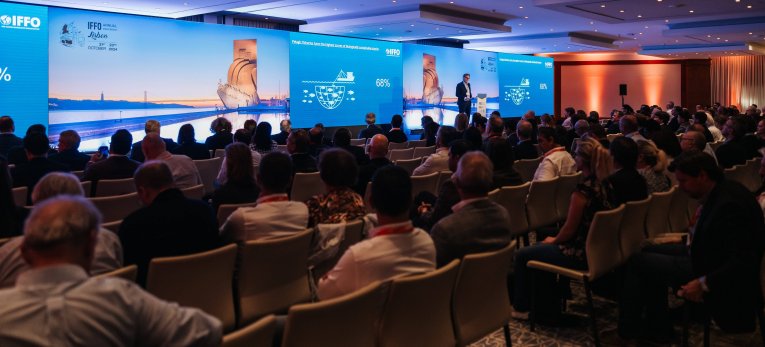
IFFO – The Marine Ingredients Organisation is holding its Annual Conference in Lisbon, Portugal, from the 21st to 23rd to October. Open to IFFO Members and non-IFFO Members interested in the marine ingredients value chain, the conference is gathering a record number of 530 delegates from 43 countries. Close to 30 speakers are discussing feed ingredient strategies for the future, supply and demand for marine ingredients and exploring the role which marine ingredients play in human health.
Explore our summary reports covering each day of the conference:
- day 1: see below
- day 2: here
- day 3: here
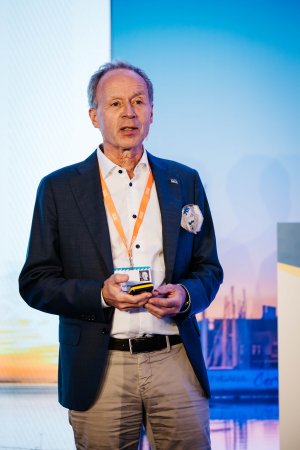 IFFO’s President, Egil Magne Haugstad, opened the conference, greeting IFFO’s 257 members from 43 countries, including 87 Producer Members, who represent IFFO’s ownership. With its mission being to represent the marine ingredients industry worldwide and to promote and undertake research, IFFO has been involved in discussions with a wide range of stakeholders and is providing a meeting place for the whole value chain.
IFFO’s President, Egil Magne Haugstad, opened the conference, greeting IFFO’s 257 members from 43 countries, including 87 Producer Members, who represent IFFO’s ownership. With its mission being to represent the marine ingredients industry worldwide and to promote and undertake research, IFFO has been involved in discussions with a wide range of stakeholders and is providing a meeting place for the whole value chain.
IFFO’s Director General, Petter Johannessen, introduced the conference referring to the United Nations’ ambition for aquaculture to keep expanding in a sustainable manner to ensure food security for now and the future. “Despite being a blind spot to many, feeds must feature in the equation. There is no growth of the aquaculture sector without growth of the feed ingredient sector. In such a world, the value of all resources needs to be explored and maximised”, he noted.
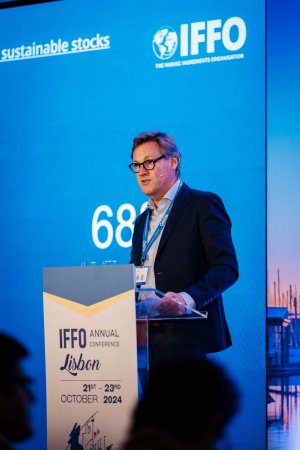 Building on IFFO’s mission to undertake and contribute to research works, he explored the main innovative aspects relating to the marine ingredients sector: collaborative fishery management, through an ecosystem approach, optimised use of resources through precision nutrition and circular raw material sourcing. “Repurposing fish resources not used in direct human consumption is a key element to that promise of growth. This process is already under way and relies on infrastructure innovation, onboard vessels and on land, stakeholder collaboration and a paradigm shift”.
Building on IFFO’s mission to undertake and contribute to research works, he explored the main innovative aspects relating to the marine ingredients sector: collaborative fishery management, through an ecosystem approach, optimised use of resources through precision nutrition and circular raw material sourcing. “Repurposing fish resources not used in direct human consumption is a key element to that promise of growth. This process is already under way and relies on infrastructure innovation, onboard vessels and on land, stakeholder collaboration and a paradigm shift”.
Johannessen ended by saying that “marine ingredients have been an important part of the past, we are the benchmark for feed ingredients today and will be a vital part of the future of food production and food security.
From globalization to protectionism
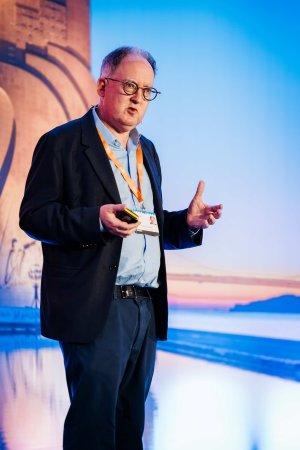 Gideon Rachman, Chief Foreign Affairs Commentator at The Financial Times, provided a fascinating overview of global geopolitics, looking at the impacts of current conflicts on access to waterways and food security. He noted that “the seafood industry is globalized, with people from every continent, which is emblematic of what has happened to the global economy. Globalisation has been an unstoppable force, but the challenge that we all face is that the political winds have changed”. Rachman then presented a global tour of conflicts and how these can impact the global economy. He noted that the world is becoming increasingly protectionist, especially in the US and China. There is a securitization of economics, which started as a reaction in the pandemic, when the vulnerability of key supply chains was revealed. This has driven the move from « just in time » to « just in case ».
Gideon Rachman, Chief Foreign Affairs Commentator at The Financial Times, provided a fascinating overview of global geopolitics, looking at the impacts of current conflicts on access to waterways and food security. He noted that “the seafood industry is globalized, with people from every continent, which is emblematic of what has happened to the global economy. Globalisation has been an unstoppable force, but the challenge that we all face is that the political winds have changed”. Rachman then presented a global tour of conflicts and how these can impact the global economy. He noted that the world is becoming increasingly protectionist, especially in the US and China. There is a securitization of economics, which started as a reaction in the pandemic, when the vulnerability of key supply chains was revealed. This has driven the move from « just in time » to « just in case ».
Nutritional benefits of ingredients, their impacts and social acceptance
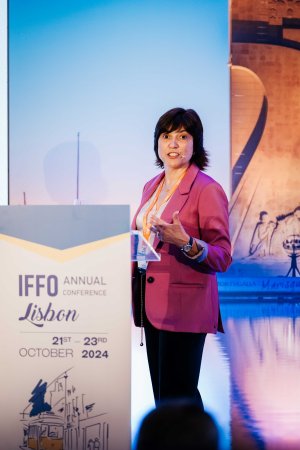 Luisa Valente, Professor at the Interdisciplinary Centre of Marine and Environmental Research, University of Porto, looked at protein ingredients and how complex messages around nutritional benefits and environmental footprint are communicated and understood by the general public. Fed fish in aquaculture have complex diets, especially salmonids, catfish and shrimp that require a lot of protein. While marine ingredients provide the best source of protein, we need to diversify and understand the nutritional value of all these ingredients, along with how the fish process them, the fillet quality, and their social acceptance. Fish fillet quality and the amount of omega-3 EPA and DHA, and vitamins and minerals depends on the feed and absorption. However, these ingredients also need to be judged on an equal footing with uniformed metrics, and marine ingredients can be sustainable if properly managed: with 62% sustainably exploited, there is still room for improvement. “Animal by-product hydrolysates help us improve the value of protein sources and aid the health of the fish. Both marine ingredients and land animal proteins have low social acceptance and we need to improve this” she concluded.
Luisa Valente, Professor at the Interdisciplinary Centre of Marine and Environmental Research, University of Porto, looked at protein ingredients and how complex messages around nutritional benefits and environmental footprint are communicated and understood by the general public. Fed fish in aquaculture have complex diets, especially salmonids, catfish and shrimp that require a lot of protein. While marine ingredients provide the best source of protein, we need to diversify and understand the nutritional value of all these ingredients, along with how the fish process them, the fillet quality, and their social acceptance. Fish fillet quality and the amount of omega-3 EPA and DHA, and vitamins and minerals depends on the feed and absorption. However, these ingredients also need to be judged on an equal footing with uniformed metrics, and marine ingredients can be sustainable if properly managed: with 62% sustainably exploited, there is still room for improvement. “Animal by-product hydrolysates help us improve the value of protein sources and aid the health of the fish. Both marine ingredients and land animal proteins have low social acceptance and we need to improve this” she concluded.
The evolution of influencers in aquaculture
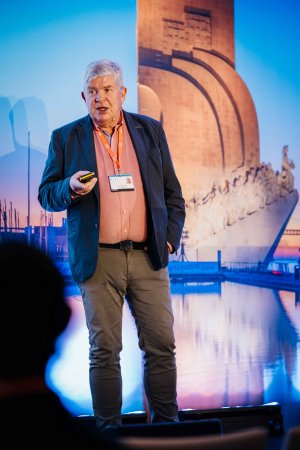 Based on his current work for the Norwegian government, and his past experience at EWOS, Dr. Einar Wathne, Industry expert and Assistant professor at Norsk Bioakva AS/NMBU, shared his insights about what future feed ingredient strategies could look like and who the influencers are. Sustainability has become a key driver in our food systems. ‘The marine sector were the pioneers in marine sustainability’, with historic action taken with Sandeel stocks, and now the development of improvement programs like Fishery Improvement Projects, and certifications like MarinTrust. “Criteria for buying ingredients will change; nutrition is a prerequisite, but after comes new sustainability criteria with a prize tag”. Wathne reviewed the drivers in the market, with the rise in prominence in feed buyers, politicians, and certifiers. For marine ingredients, Wathne suggested that producers need to adapt to new or extended buying criteria and possibly shortcut the value chain links, and go directly downstream to retailer or NGOs.
Based on his current work for the Norwegian government, and his past experience at EWOS, Dr. Einar Wathne, Industry expert and Assistant professor at Norsk Bioakva AS/NMBU, shared his insights about what future feed ingredient strategies could look like and who the influencers are. Sustainability has become a key driver in our food systems. ‘The marine sector were the pioneers in marine sustainability’, with historic action taken with Sandeel stocks, and now the development of improvement programs like Fishery Improvement Projects, and certifications like MarinTrust. “Criteria for buying ingredients will change; nutrition is a prerequisite, but after comes new sustainability criteria with a prize tag”. Wathne reviewed the drivers in the market, with the rise in prominence in feed buyers, politicians, and certifiers. For marine ingredients, Wathne suggested that producers need to adapt to new or extended buying criteria and possibly shortcut the value chain links, and go directly downstream to retailer or NGOs.
In Norway, currently, 8% of marine ingredients for farmed fish is currently produced domestically. There is a stated mission to increase this proportion to 25% by 2034, which is 10 years from now: “The Norwegian government has announced that sustainable feed for farmed animals is one of its missions. This initiative sets the tone for a collective effort to address three objectives” he said: reduce climate emissions and preserve biodiversity, increase supply security, develop a strong feed ingredient industry in Norway.
Not the apocalypse but we still need action
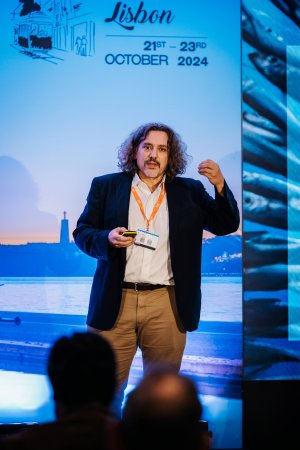 Jim Cannon, CEO of Sustainable Fisheries Partnership, added that it was necessary to future-proof feed to protect nature and promote climate change resilience. “Fisheries need investment to improve and the industry cannot rely on governments to manage their fisheries” he noted. With population growth peaking in 1962 and fossil investments being replaced with energy transition, climate impacts are slowly improving, he added. Deforestation still needs to be reduced so plant ingredients need to be carefully and sustainably sourced going forward. But fisheries will still be impacted by rising temperature levels and decreasing oxygen levels, leading to a reduction in fish productivity and increasing volatility. Fisheries will be harder to manage so the industry will need to work with governments to help with fisheries data, develop regulations, and improve compliance. Canon ended by saying that “aquaculture needs to be positioned as a low-carbon source of protein that will help ensure future food demand. Consumers should be encouraged to buy from companies who are taking action and driving change”.
Jim Cannon, CEO of Sustainable Fisheries Partnership, added that it was necessary to future-proof feed to protect nature and promote climate change resilience. “Fisheries need investment to improve and the industry cannot rely on governments to manage their fisheries” he noted. With population growth peaking in 1962 and fossil investments being replaced with energy transition, climate impacts are slowly improving, he added. Deforestation still needs to be reduced so plant ingredients need to be carefully and sustainably sourced going forward. But fisheries will still be impacted by rising temperature levels and decreasing oxygen levels, leading to a reduction in fish productivity and increasing volatility. Fisheries will be harder to manage so the industry will need to work with governments to help with fisheries data, develop regulations, and improve compliance. Canon ended by saying that “aquaculture needs to be positioned as a low-carbon source of protein that will help ensure future food demand. Consumers should be encouraged to buy from companies who are taking action and driving change”.
Referring to SFP’s newly launched feed solutions toolkit, he noted that “aquaculture feed remains a significant climate change and environmental hotspot – with risks such as land conversion, deforestation, overexploitation, pollution, and bycatch from the production or capture of feed ingredients”.
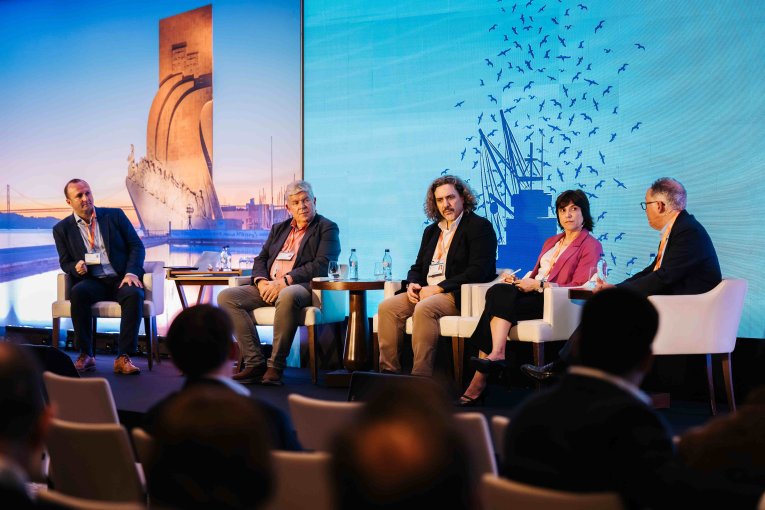
Moderated by Robin Paxton, Editor in chief at Intrafish, a panel discussion featuring Gideon Rachman, Luisa Valente, Jim Cannon and Dr Einar Wathne, explored the role of marine ingredients in feeding the world.
Local and circular
Local procurement is getting more and more traction as part of sourcing policies. So does utilisation of circular raw materials: 38% of fishmeal and fish oil production comes from fish by-products (2023). “We are increasing the use from by-products, but there are limitations on their uses, such as with inter species, and the constraints on using different sub streams; the legal teams are not evolving to incentivise the usage of these ingredients” Luisa Valente noted.
A complex sector and multifaceted responsibilities
Feed is a complex sector. “The public doesn’t know about long chain omega-3s, let alone about the diversity of fishmeals or their nutritional benefits. Fishmeal is not only about protein” Valente insisted.
“We’re in a room full of 500+ industry experts, who understand the business, its success stories and its challenges”, Paxton stated. Ultimately, however, it’s the consumer that buys the fish, the shrimp, the seafood at the end of the supply chain. It’s the consumer that needs to be convinced. Where do responsibilities lie in supporting positive changes?
Fisheries efforts have been previously funded by the cost on the goods, Cannon noted. But things are changing, companies now know their sources, their buyers, and with this data they are driving down costs. “Retailers are now building finance funding with investors to ensure responsible supply in industries such as soy and we are starting this in fisheries. The industry needs to collaborate and fill the gaps left by government” he concluded. Valente suggested that the industry should invest in academia to solve problems and ensure there is a level of trust to share data and close the information gap.
Industry’s leadership in innovation
Norway’s willingness to increase the sourcing of green and locally-sourced raw materials for its aquaculture sector means a huge industrial lift: “The science is not the limitation, Wathne noted, but we need the capital to meet this, either by stimulation or regulation. We have set the target and the industry is working on the tools to achieve this is on the agenda”.
Globalisation and its implications
Beyond communications efforts, sharing good practices is instrumental. “The US seafood has large seafood exports so could consume more, EU is more dependent on imports. If global trade was to be reduced, then we would see less positive development in fisheries. As countries develop, they do invest more in their nature, and Europe has an outsized impact globally”, Cannon noted.
In a stage where governments are trying to protect themselves from over dependence, food is not seen as a critical industry. However, Rachman noted that “there could be a situation where seas are blockaded. Outsourcing food supply has now become a worry because we are now closer to great power conflicts. Fisheries have always been contested, the EU’s Common fisheries policy is much lampooned, but without it there will be wars between fishing boats. Food supplies and self reliance is becoming part of national strategies”, he concluded.








